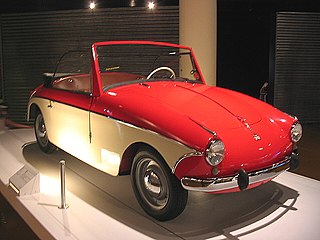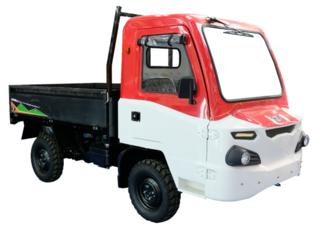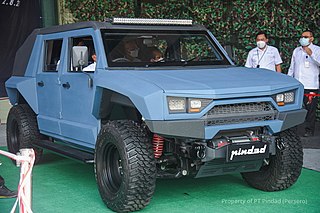
The Toyota Avanza and Daihatsu Xenia are a series of multi-purpose vehicles (MPV) developed by Daihatsu and marketed by both Toyota and Daihatsu, mainly sold with three-row seating. The Avanza and Xenia were developed as an entry-level MPV marketed mainly for the Indonesian and other emerging markets, and mainly produced in Indonesia by Astra Daihatsu Motor. Avanza's spiritual predecessor was the Kijang, whose model program has since been split into two different models to expand Toyota's reach in the MPV sector.

The Toyota Innova is a series of multi-purpose vehicles (MPV) manufactured by the Japanese carmaker Toyota since 2004, mainly sold with three-row seating. Its official name in Indonesia is Toyota Kijang Innova, while for other countries it is simply called "Innova". For the second generation, it is known as Toyota Innova Crysta in India and Thailand. For the third generation, it received another moniker in Indonesia as the Toyota Kijang Innova Zenix and in India as the Toyota Innova HyCross.

PTV was a trademark of Automóviles Utilitarios S. A. a microcar manufacturer based in Manresa, near Barcelona, Spain. The PTV brand was at one time the second biggest volume microcar sold in Spain, beaten only by the Biscúter. Compared to the Biscúter it was more luxurious, offering proper doors, two-tone paint, chrome trim and 12 inch wheels.

The Toyota Fortuner, also known as the Toyota SW4, is a mid-size SUV manufactured by the Japanese automaker Toyota since 2004. Built on the Hilux pickup truck platform, it features two/three rows of seats and is available in either rear-wheel drive or four-wheel drive configuration. It is a part of Toyota's IMV project for emerging markets, which also includes the Hilux and the Innova.

The Volkswagen Country Buggy is a small utility vehicle designed and built by Volkswagen in Australia. It used parts from the existing Type 1 and Type 2. Production ran from 1967 to 1968. A derivative of the Country Buggy called the Sakbayan was built in the Philippines for several years until 1980.

Arola SARL was a small manufacturing company based in Lyon-Corbas, France, which manufactured a range of microcars, designed to be driven without a license. Arola became part of the Aixam group in 1983.

The Honda Brio is a city car produced by Honda since 2011. It is mainly sold in Southeast Asia and also in other regions, positioned as an entry-level hatchback model slotted below the Fit/Jazz and the City. Along with the complementary Amaze sedan, it is the smallest car in Honda's global line-up as of 2023, excluding Japanese market kei cars.

The Daihatsu Ayla is a city car designed by Daihatsu and manufactured by Astra Daihatsu Motor in Indonesia since 2013, primarily developed for emerging markets. The Ayla has also been sold by Toyota as the Toyota Agya in Indonesia, South Africa, Tunisia and Americas, and the Toyota Wigo in the Philippines, Sri Lanka, Brunei and Vietnam through an OEM agreement. The car is also slightly reengineered and manufactured in Malaysia by Perodua as the Perodua Axia.

The Pindad Komodo or Pindad Dragon for export markets is a 4x4 light armored car developed and produced by Pindad. The vehicle was developed after Indonesian president Susilo Bambang Yudhoyono made a visit to Pindad's main office and asked them to create an indigenous tactical vehicle in order to serve the needs of the Indonesian police and military as an alternative to other 4x4 tactical vehicles such as the Humvee as a personal challenge to the company. The vehicle was given its present name by President Yudhoyono after it was unveiled to the public at the 2012 Indo Defence Expo and Forum in Jakarta, Indonesia so that the Komodo can have a strong impression "at any combat field and could bring the glory for Indonesia.", especially since the Komodo dragon is an endemic animal native to Indonesia.

KM Racing Team was created in 2008 by connection of Martin Macik's Truck Team and Pavel Kubicek's motorcycle team. Martin Macík was a pilot of truck Liaz participating in the Dakar Rally since 2003 and as one team called KM Racing linked since Dakar moved to South America in 2009. During the four South American Races the team used trucks Liaz with pilots Macík Martin, Ladislav Fajtl, Vlastimil Vildman and Jaroslav Valtr, motorcyclists David Pabiska, Randysek Dusan and Ivan Jakes and quad riders Josef Machacek and Martin Plechaty.

The Toyota GD engine series is a diesel engine produced by Toyota which appeared in 2015. It replaced the Toyota KD engine series as a diesel engine series mainly oriented to body-on-frame vehicles. The GD engine featured Economy with Superior Thermal Efficient Combustion (ESTEC) technology. Toyota claims they have a maximum thermal efficiency of 44 percent, "top class" at the time of introduction.

The DFSK C-Series is a series of light commercial vehicles manufactured by the Chinese automaker DFSK Motor, a joint venture between Dongfeng Motor and Sokon Industry. The van models were first unveiled on September 21, 2009, whereas the pickup truck models were launched later. The van is available in three different models, the C35, the C36, and the C37. While the pickup is available in four different models, the single cab models are being the C31 and C51, while the double cab models were the C32 and C52.

PT Solo Manufaktur Kreasi, trading as Esemka, is an Indonesian automotive company based in Solo, Indonesia. The "Esemka" brand was named as the abbreviation of vocational high school to recognize the effort of the students to develop the native car brand. Though initially local media used to term it as national car brand of Indonesia, but the company described Esemka as a vehicle which is totally made in Indonesia. Since 2013 an average of 10 units of SUV and mini trucks had been manufactured per month by the company. The company started commercial production of various model of cars and minivan in its manufacturing plant at Demangan village, Boyolali Regency in Central Java since 2016. It was officially inaugurated by Indonesian President Joko Widodo on 6 September 2019. At the time of inauguration, the manufacturing plant has production capacity of 12,000 vehicles per year. Esemka uses locally made components from companies such as PT INKA and Pertamina.

AMMDes is an agricultural vehicle produced by PT Kreasi Mandiri Wintor Indonesia (KMWI). This vehicle is categorized as rural car. The local content of AMMDes reaches 73%. The price of the base model is Rp70 million, not including the equipment it carries. The cheapest equipment price is the irrigation pump and the most expensive is the water purifier. From the certification carried out by the Ministry of Industry and PT Surveyor Indonesia, it is known that AMMDes has a TKDN of 40.92%.

Pindad Maung is an all-terrain, all-wheel drive light vehicle produced by Pindad. Initially designed as a military light utility-type vehicle, civilian versions are also available. The name Maung means "tiger" in Sundanese.
Texmaco Perkasa is a family of medium-duty commercial vehicles manufactured by Indonesian automaker PT Wahana Perkasa Auto Jaya, which is a company under the Texmaco group. Started production after the New Order in 1999 by making trucks, and in 2001 finally participated in producing variants of bus vehicles. Perkasa means "mighty" in Indonesian. These vehicles are well known in Indonesia for being the standard trucks and buses operated by the Indonesian Armed Forces. Perkasa truck was first launched in late 1998, with a claim of 90% local content. TNI and Polri are the first customers, intended as military vehicles and tactical vehicles. Perkasa stopped production in 2004 after the Texmaco group went bankrupt by IBRA.

PT Kreasi Mandiri Wintor Indonesia (KMWI) is an Indonesian automotive manufacturer. It is a subsidiary of PT Astra Otoparts Tbk.

PT Fin Komodo Teknologi is an Indonesian automotive manufacturer based in Cimahi, West Java.

The MV2 is an SUV / light military vehicle developed by the Indonesian defense equipment company Pindad. These vehicles are designed for a variety of uses, from military vehicles to civilian off-road vehicles. MV2 variants that will be developed such as pickup trucks, wagons, and specialized variants that can be used for military operations.

The Wuling Air EV is a battery electric city car manufactured by SAIC-GM-Wuling (SGMW) since 2022. Based on SGMW's Global Small Electric Vehicle (GSEV) platform, the model is the third GSEV model to be marketed under the Wuling brand after the Hongguang Mini EV and the Nano EV.




















